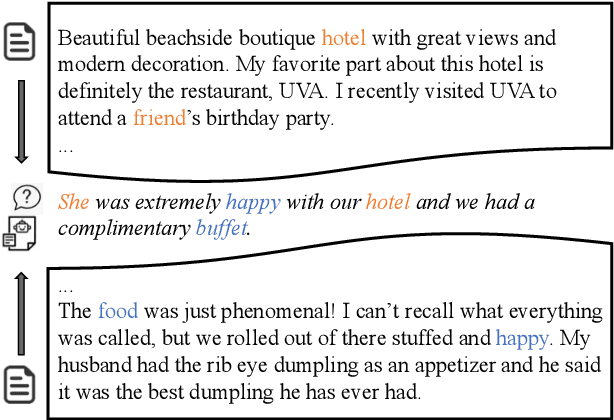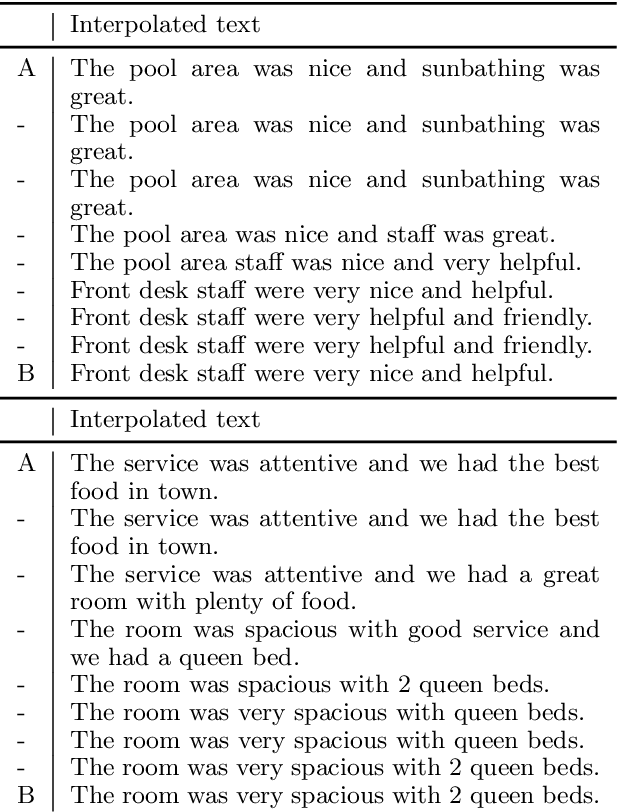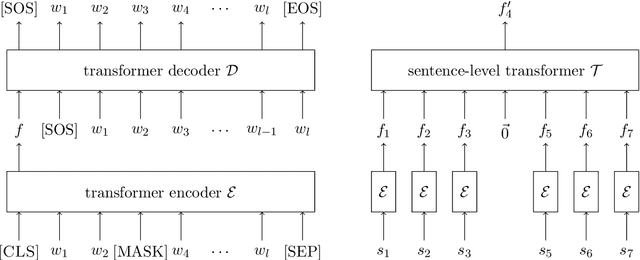Oussama Elachqar
Can a Single Model Master Both Multi-turn Conversations and Tool Use? CALM: A Unified Conversational Agentic Language Model
Feb 12, 2025Abstract:Large Language Models (LLMs) with API-calling capabilities enabled building effective Language Agents (LA), while also revolutionizing the conventional task-oriented dialogue (TOD) paradigm. However, current approaches face a critical dilemma: TOD systems are often trained on a limited set of target APIs, requiring new data to maintain their quality when interfacing with new services, while LAs are not trained to maintain user intent over multi-turn conversations. Because both robust multi-turn management and advanced function calling are crucial for effective conversational agents, we evaluate these skills on three popular benchmarks: MultiWOZ 2.4 (TOD), BFCL V3 (LA), and API-Bank (LA), and our analyses reveal that specialized approaches excel in one domain but underperform in the other. To bridge this chasm, we introduce CALM (Conversational Agentic Language Model), a unified approach that integrates both conversational and agentic capabilities. We created CALM-IT, a carefully constructed multi-task dataset that interleave multi-turn ReAct reasoning with complex API usage. Using CALM-IT, we train three models CALM 8B, CALM 70B, and CALM 405B, which outperform top domain-specific models, including GPT-4o, across all three benchmarks.
Do LLMs "know" internally when they follow instructions?
Oct 22, 2024



Abstract:Instruction-following is crucial for building AI agents with large language models (LLMs), as these models must adhere strictly to user-provided constraints and guidelines. However, LLMs often fail to follow even simple and clear instructions. To improve instruction-following behavior and prevent undesirable outputs, a deeper understanding of how LLMs' internal states relate to these outcomes is required. Our analysis of LLM internal states reveal a dimension in the input embedding space linked to successful instruction-following. We demonstrate that modifying representations along this dimension improves instruction-following success rates compared to random changes, without compromising response quality. Further investigation reveals that this dimension is more closely related to the phrasing of prompts rather than the inherent difficulty of the task or instructions. This discovery also suggests explanations for why LLMs sometimes fail to follow clear instructions and why prompt engineering is often effective, even when the content remains largely unchanged. This work provides insight into the internal workings of LLMs' instruction-following, paving the way for reliable LLM agents.
Large-scale Training of Foundation Models for Wearable Biosignals
Dec 08, 2023Abstract:Tracking biosignals is crucial for monitoring wellness and preempting the development of severe medical conditions. Today, wearable devices can conveniently record various biosignals, creating the opportunity to monitor health status without disruption to one's daily routine. Despite widespread use of wearable devices and existing digital biomarkers, the absence of curated data with annotated medical labels hinders the development of new biomarkers to measure common health conditions. In fact, medical datasets are usually small in comparison to other domains, which is an obstacle for developing neural network models for biosignals. To address this challenge, we have employed self-supervised learning using the unlabeled sensor data collected under informed consent from the large longitudinal Apple Heart and Movement Study (AHMS) to train foundation models for two common biosignals: photoplethysmography (PPG) and electrocardiogram (ECG) recorded on Apple Watch. We curated PPG and ECG datasets from AHMS that include data from ~141K participants spanning ~3 years. Our self-supervised learning framework includes participant level positive pair selection, stochastic augmentation module and a regularized contrastive loss optimized with momentum training, and generalizes well to both PPG and ECG modalities. We show that the pre-trained foundation models readily encode information regarding participants' demographics and health conditions. To the best of our knowledge, this is the first study that builds foundation models using large-scale PPG and ECG data collected via wearable consumer devices $\unicode{x2013}$ prior works have commonly used smaller-size datasets collected in clinical and experimental settings. We believe PPG and ECG foundation models can enhance future wearable devices by reducing the reliance on labeled data and hold the potential to help the users improve their health.
Contextual Text Style Transfer
Apr 30, 2020



Abstract:We introduce a new task, Contextual Text Style Transfer - translating a sentence into a desired style with its surrounding context taken into account. This brings two key challenges to existing style transfer approaches: ($i$) how to preserve the semantic meaning of target sentence and its consistency with surrounding context during transfer; ($ii$) how to train a robust model with limited labeled data accompanied with context. To realize high-quality style transfer with natural context preservation, we propose a Context-Aware Style Transfer (CAST) model, which uses two separate encoders for each input sentence and its surrounding context. A classifier is further trained to ensure contextual consistency of the generated sentence. To compensate for the lack of parallel data, additional self-reconstruction and back-translation losses are introduced to leverage non-parallel data in a semi-supervised fashion. Two new benchmarks, Enron-Context and Reddit-Context, are introduced for formality and offensiveness style transfer. Experimental results on these datasets demonstrate the effectiveness of the proposed CAST model over state-of-the-art methods across style accuracy, content preservation and contextual consistency metrics.
INSET: Sentence Infilling with Inter-sentential Generative Pre-training
Nov 10, 2019



Abstract:Missing sentence generation (or sentence infilling) fosters a wide range of applications in natural language generation, such as document auto-completion and meeting note expansion. Such a task asks the model to generate intermediate missing sentence that can semantically and syntactically bridge the surrounding context. Solving the sentence infilling task requires techniques in NLP ranging from natural language understanding, discourse-level planning and natural language generation. In this paper, we present a framework to decouple this challenge and address these three aspects respectively, leveraging the power of existing large-scale pre-trained models such as BERT and GPT-2. Our empirical results demonstrate the effectiveness of our proposed model in learning a sentence representation for generation, and further generating a missing sentence that bridges the context.
 Add to Chrome
Add to Chrome Add to Firefox
Add to Firefox Add to Edge
Add to Edge